What are rose supports and how to use them?

Climbing rose stems, depending on the variety, grow from 1.5 to 15 meters in length. The run-up of dimensions affects the choice of supports for each specific case. Not all plants in this category are capable of creating a thick shady gazebo; for some varieties, a simple support in the form of a pillar may be needed. But no matter how the curly rose is decorated, it will always remain the best decoration of the site.
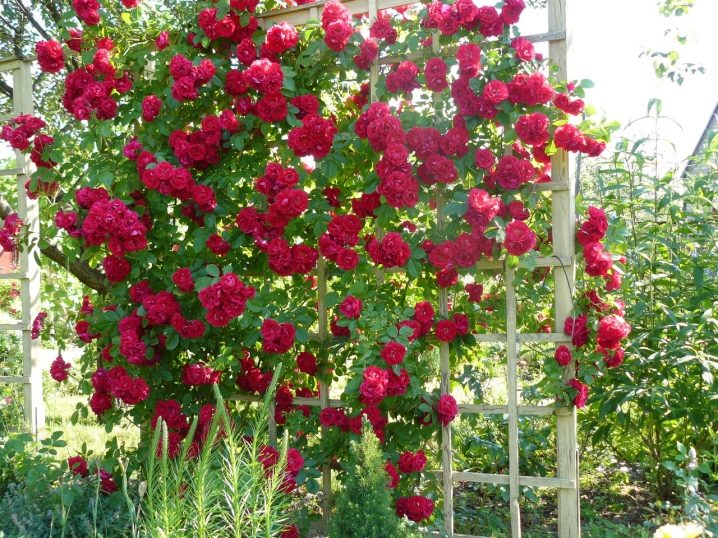
Requirements
There are vines in the wild; they grow in Southeast Asia. Plants find their own support in the form of neighboring bushes, trees, rocky ledges. Domestic roses need hand-made supports, the production of which has certain requirements.


Strength and stability
The rose seems to be a refined and delicate plant, but in the total mass of vines, branches, foliage and buds, it acquires an impressive weight, which not every structure can withstand. It is necessary to immediately take care of the reliability of the supports so that they do not have to be redone when the plant grows up. It is best to choose wood or metal to support the weaving stem. The structure must be dug into the ground or fastened to the wall.
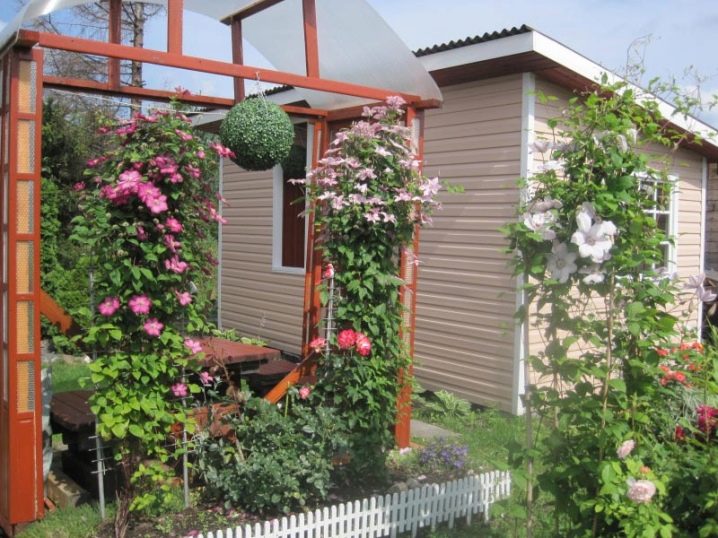
Decorativeness
In addition to practicality, aesthetic requirements are also imposed on the support product. Some owners build a gazebo from rusty fittings and contemplate the twigs for years, waiting for the rose to grow. You need to immediately think over the design of the support, stylize it to match the surrounding landscape. In a partnership, the support-bush takes the leading place, which means that the support should be made as inconspicuous as possible - paint it green, use strong but sophisticated materials for its construction.
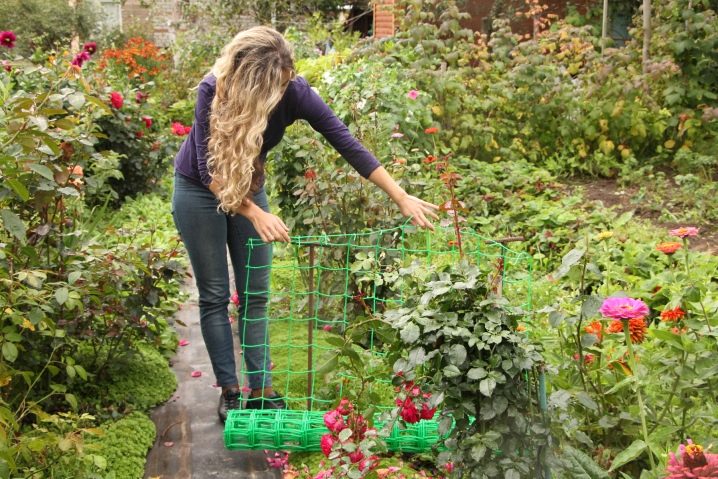
Some gardeners construct sculptural supports, turning a rose bush into a ball, cone, cube. You cannot achieve ideal geometric shapes from a rose, she does not really like to follow given shapes. It is better to make the support itself decorative, graceful, but not drawing attention to itself. Such a product will be able to unobtrusively complement the bush and at the same time delight with its artistic lines.
As examples, we offer a selection of spectacular designs.
- A beautiful arch with partial pink braiding becomes an extravagant garden decor.
- As the bush grows, the airy wrought-iron gazebo dresses up in a delightful floral outfit.
- An umbrella-shaped support forms a lush flowering tree from a rose bush.


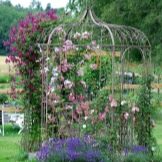
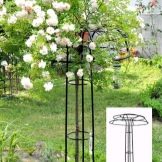
Comparability to variety
We have already noted that the length of the vines depends on the variety. This should be taken into account when constructing supports. You can not install a fragile support for tall varieties, no matter how elegant it looks... As it grows, the powerful plant will crush it with its weight. Reliable load supports are not suitable for relatively low grades. Against their background, the beauties of roses will look small and will not be able to fully provide the spectacular look of the bush that is expected of them.
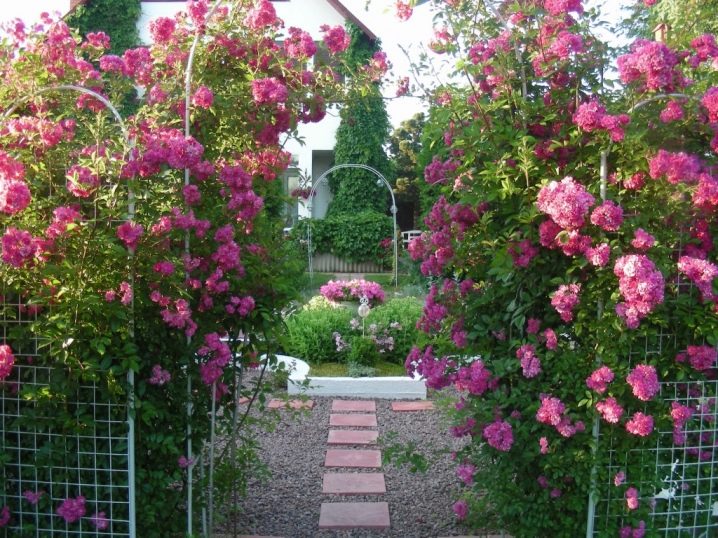
Convenience and simplicity
Supports should be installed as simple and convenient as possible... The gardener will feel the relevance of this requirement when he is faced with caring for a climbing rose. The plant is unable to wrap around the support on its own - the maximum it can do is catch on the thorns. The owner of the bush, as the latter grows, will have to manually tie the branches to the props. Free access to the plant will help facilitate the work. Many garden varieties in the winter are removed from the supports and covered, protecting them from frost.In this case, minimalism of the supporting structure is simply necessary. Complex support shapes or the presence of a fine mesh will significantly complicate the task.
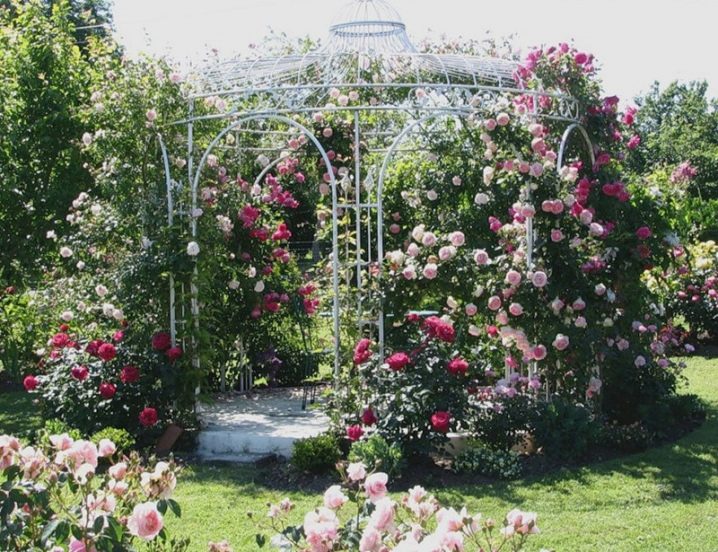
Profitability
The supporting structure can be purchased ready-made at garden exhibitions or ordered from specialists. But the simplicity of making supports allows you to make your own assembly, choosing inexpensive but strong materials. Props are necessary for most rose bushes, at least in minimal versions, the only exceptions are curb and ground cover species. Does not need supports and floribunda.
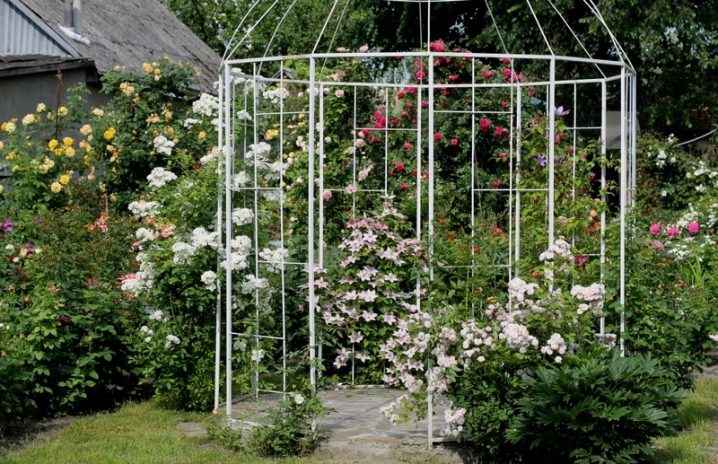
Views
In the landscape design of a country house or summer cottage, climbing roses are often used as vertical gardening. Having chosen a suitable place on the site, first install a stand corresponding to the variety that is going to be planted. If you do the opposite and dig in the holder next to an already growing bush, you can accidentally damage the roots.
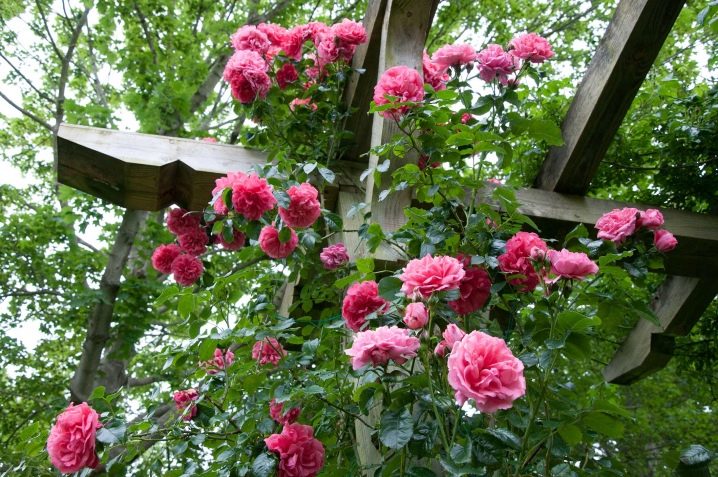
There are many types of supports, including round and vertical posts, arches and pergolas, trellises and pyramids. Sometimes the branches of the rose are directed to the fences or walls of the building, using fasteners to tie the shoots. Instead of mounts on the wall, you can mount ready-made gratings along which the plant will trail.
The rose should be planted at a distance of 50-80 cm from the fence so that the root system can develop freely.
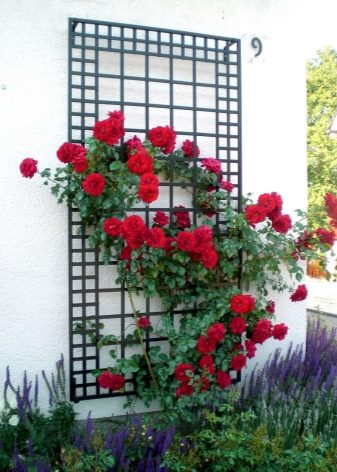
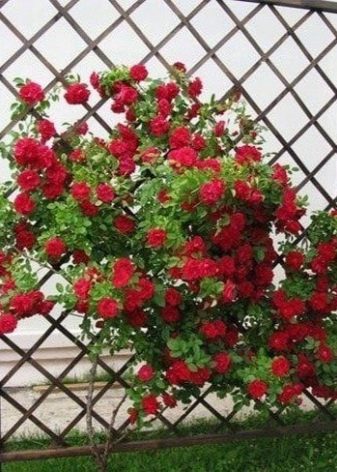
The following types of supports are most common.
Trellis mesh
The trellis net can be purchased from specialized stores. From it you get the simplest kind of holders: just dig in two pillars and pull a wire mesh between them, or install it on a frame and then fix it on the wall. A wooden trellis looks more decorative, it is organically integrated into the garden design. Such a product is usually the frame is made of beams with crossed planks on the inside, but there are other, more artistic options. Forged metal trellises are especially beautiful. Despite their strength and reliability, they look light and elegant.
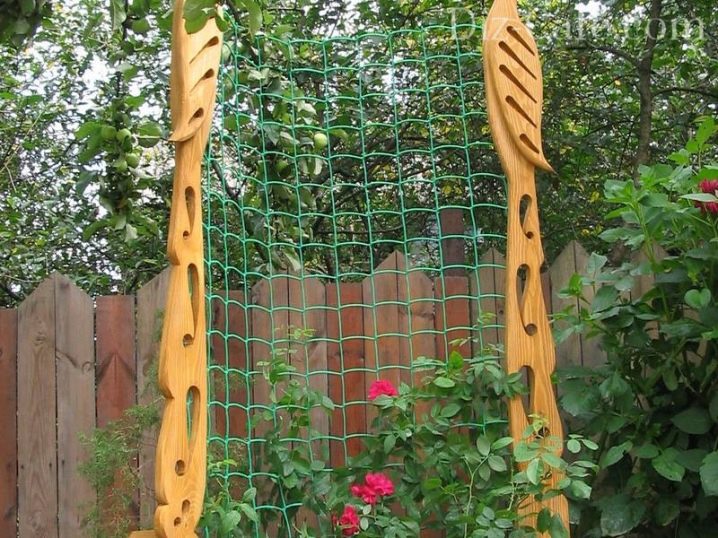
Arches and pergolas
The arch is a structure on pillars with a rounded line at the top... This shape distributes the load in the best way and allows you to withstand the weight of even the heaviest bushes. In addition to being an ideal support for roses, the arch serves as an effective decorative element. And also with its help it turns out well to zone the site, for example, to separate the courtyard from the garden by placing an arched support above the path in the right place.
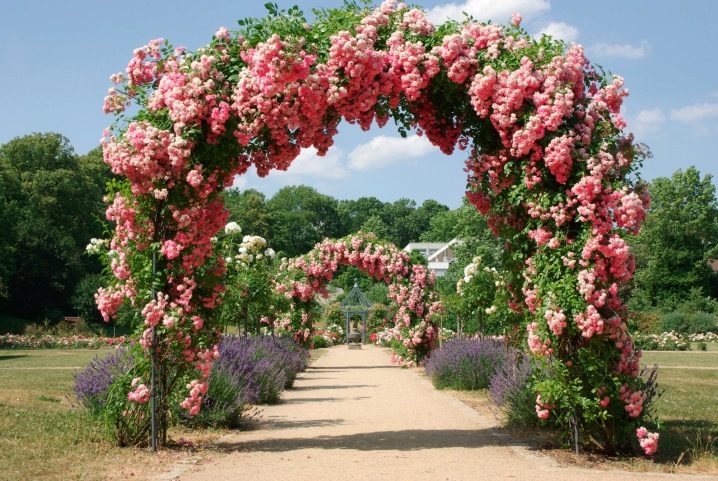
More wonderful than an arch made of rose bushes can only be an arcade - a whole series of arched vaults. It is breathtaking as you walk through a corridor of blooming and fragrant splendor.
The pergola has 4 legs and a lattice roof. Larger structures resemble gazebos. If you try, you can fill the air roof and walls with a blooming mass. Rose bushes will create a pleasant shade for relaxation. In such a place, you can install a bench, swing, a small table.
When planting rose bushes near pergolas and arches, it is better to choose long-flowering varieties or several types of plants with different flowering periods, then the fragrant miracle in the garden will linger for a long time.

Here are some examples of arches and pergolas that serve as supports for rose bushes and stunning country décor.
- A bench surrounded by an arch becomes a comfortable seating area located in a picturesque place.
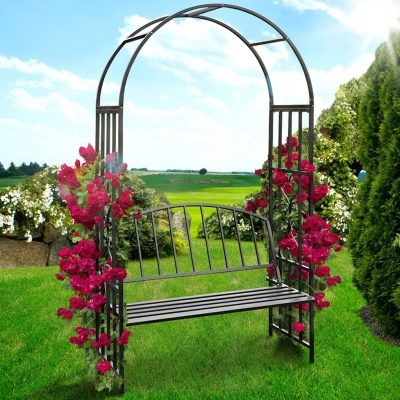
- The magical beauty of the endless arched corridor, planted with roses, captivates.

- A small pergola is organically integrated into the beautiful mountain landscape.
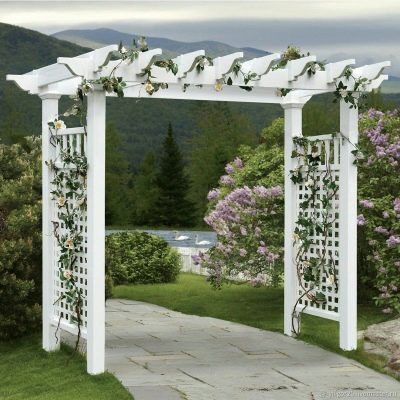
- The tea rose not only looks amazing on the arch, but also smells great.

- The shady vault of rose bushes is the best place for relaxation and private conversation.
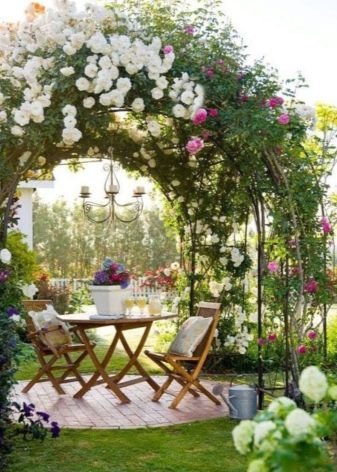
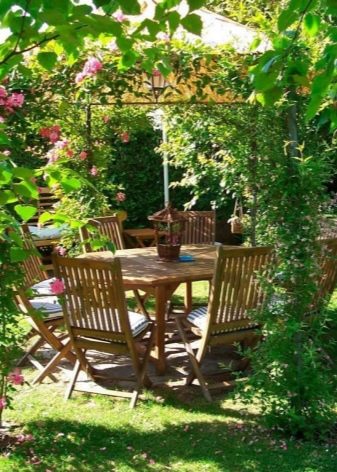
Pillars
The pillars are suitable for tall shrub roses with erect stems; for climbing vines, more voluminous structures are needed.The bush is tied to the stand as it grows, the plant that has grown in breadth complicates the approach to the support. Supports are made of metal or wood, but there are also concrete options. The photo shows how a concrete lamppost was used in the park area to support a rose bush. The result is a vibrant vertical decor that hides the unsightly look of the concrete.
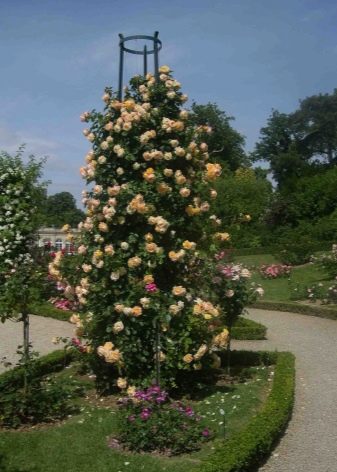

Racks are most often made and installed by the owners of rose bushes on their own, sometimes using beautiful curly options. But you can also purchase finished products in specialized stores. For example, a screw metal pillar is inserted deep into the ground by the method of rotation; it does not need to be concreted. Metal fasteners (KS 91) for racks are purchased at construction outlets. They are hammered into the ground, then a bar is inserted into the hole of the fastener, which will later serve as a support for the rose.
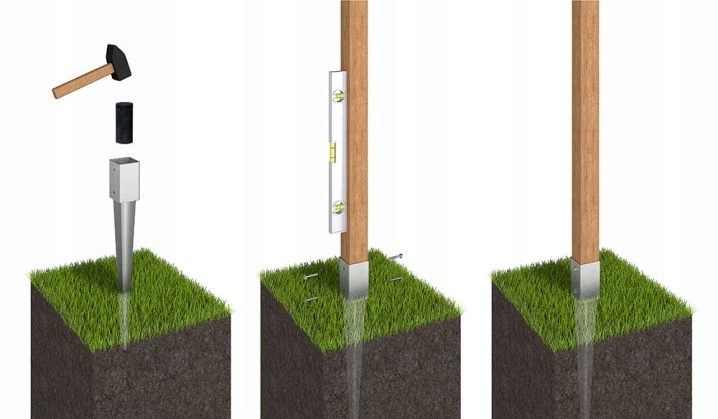
Other types of supports
Supports are different, the direction of development of the rose bush and its further appearance depend on their shape. Sometimes the props themselves become part of the garden's decor: curly, as in the photo, made in the form of a guitar, a boat, a bicycle.
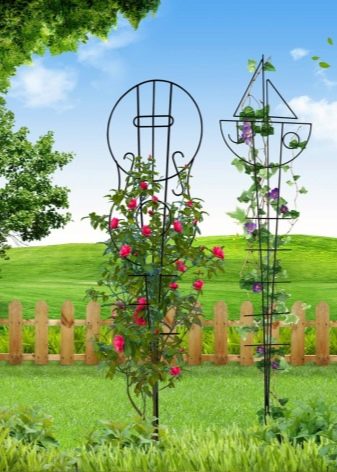
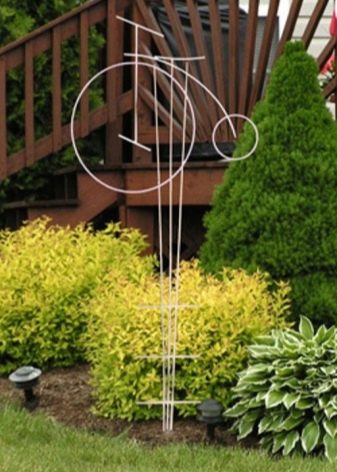
Pillars with a beautiful braiding with curly elements that serve as fasteners for the plant can also become a successful decoration of the landscape. Each post is crowned with a carved cone, completing the elegant post.
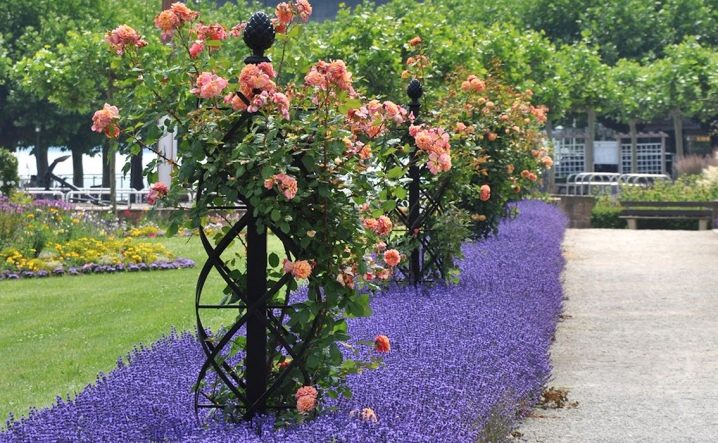
The pyramid-shaped metal bush holders enclose the plant within them. An actively growing bush is held by a frame, which eventually becomes almost invisible surrounded by branches. Supports-umbrellas raise the rose high above the ground. By removing the branches to the top of the structure, gardeners get a lush fireworks display of roses on an elongated stem.
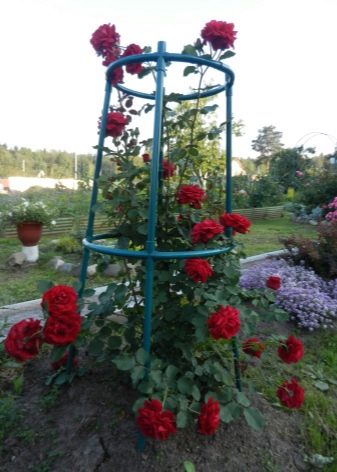
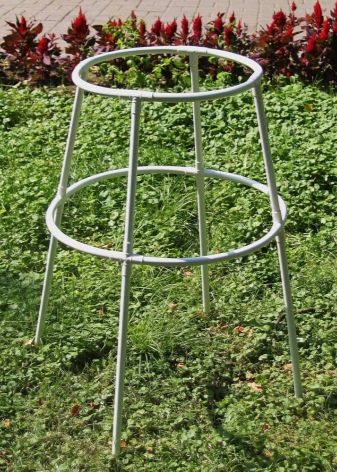
Even an ordinary garden stepladder can handle the support function. Branches inserted between the rungs of the stairs hold the rosebush securely above the ground.
Materials (edit)
The main requirements for the material of the supports are reliability and durability... After all, they will have to serve in street conditions, so it is better to use structures that can withstand dampness, frost and the scorching sun.
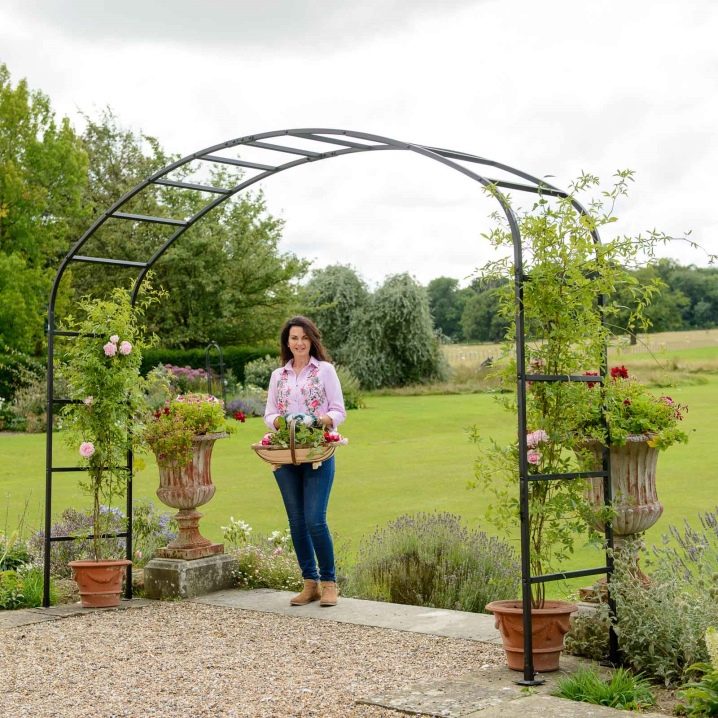
Wood
The wood is organically integrated into the overall picture of the garden, as if it sprouts along with the roses. But only expensive dense varieties of plants differ in durability. For these purposes, larch is ideal, over time it literally "turns to stone", and no moisture is afraid of it. Antibacterial impregnation, staining or varnishing will help to protect any type of wood.
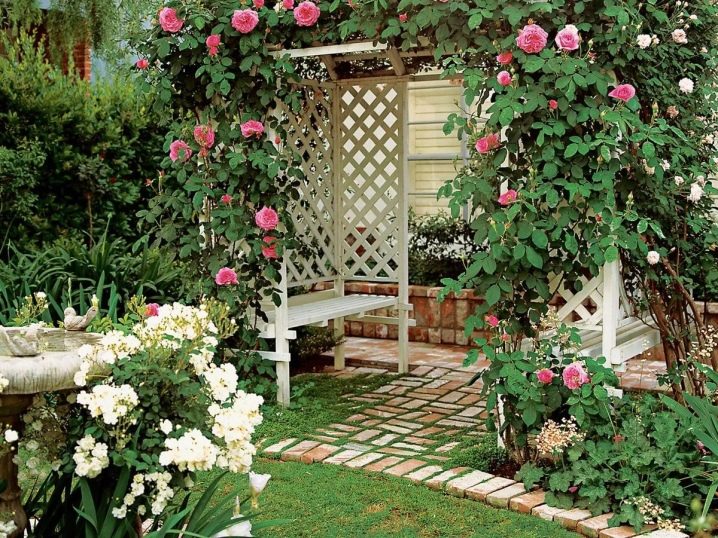
Metal
Metal structures are particularly durable and reliable, while they can be graceful and seem lightweight. Such properties make it possible to well combine extravagant props with a delicate queen of flowers. The forged props are especially impressive. In the fight against rust, the metal is treated with anti-corrosion compounds and painted.

How to do it yourself?
Summer residents themselves make stands for roses or a trellis, it is not difficult to correctly complete the design. Where the rose bush will be, two supports are dug in and cemented. If you go the easy way, you can simply pull a large mesh netting between them. But a wooden frame with cross-shaped planks will look more aesthetically pleasing. It is attached to the racks so that the bush, as it grows, is tied to the trellis plane to the lattice plane.
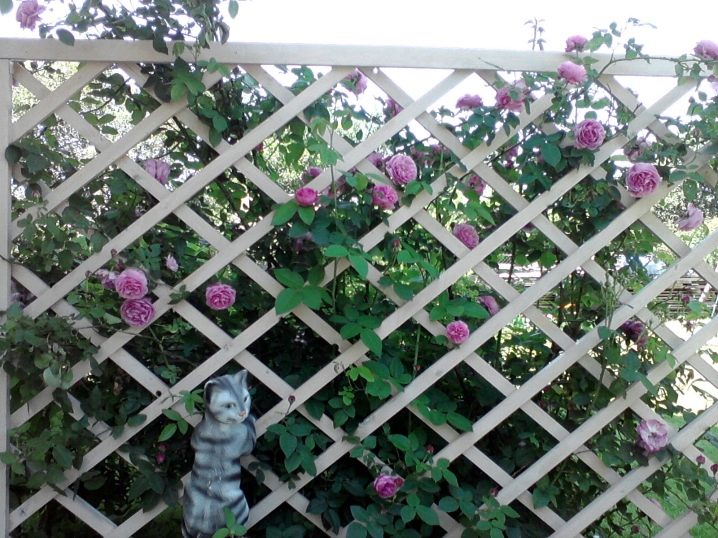
How to tie roses?
A plant is formed, almost from the first day, directing it along pre-prepared props. The appearance of the bush directly depends on the type of supports. A rose is tied in the following ways.
- Branches are fixed horizontally on a grid or lattice surface (trellis).
- Around the pillars and decorative racks, the liana trunk is directed in a spiral.
- In cones or for the growth of green mass in arches and pergolas, the stems are allowed to stand vertically.
- Filling the plane of the fence or wall with roses is carried out in a fan-like manner.
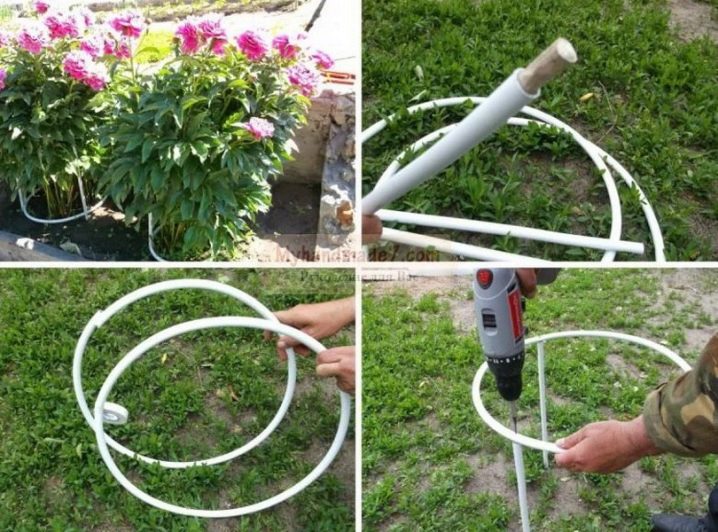
When forming a beautiful bush, in addition to a garter, pruning is also necessary, allowing you to remove chaotically protruding branches, as well as diseased and dried parts of the plant.
For information on how to make a support for roses with your own hands, see the next video.

































































































The comment was sent successfully.